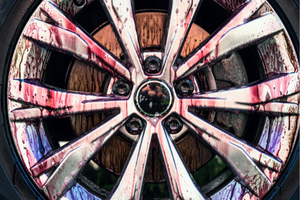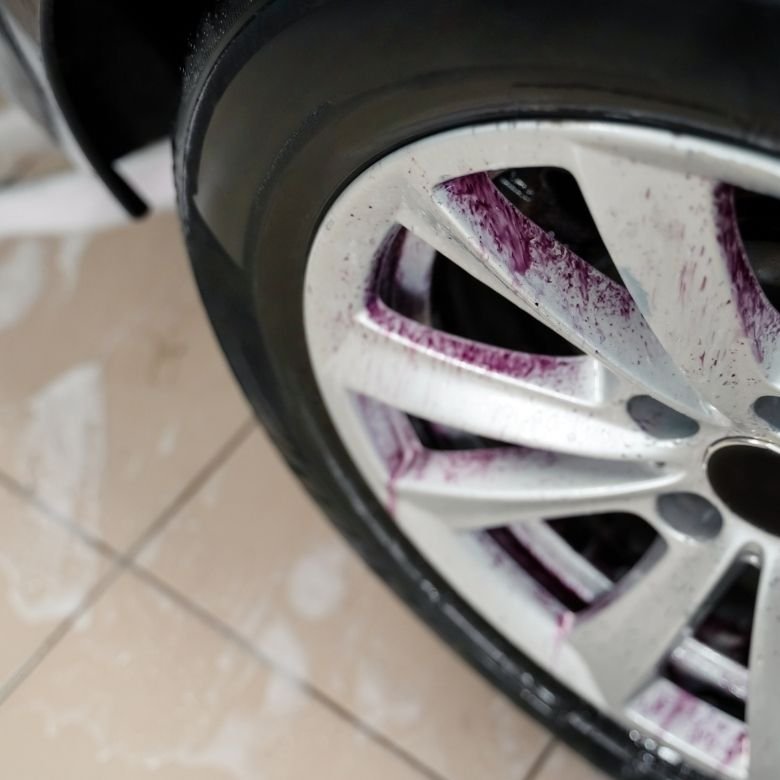Among the specialists dealing with professional car detailing, there is a saying that ‘wheels are the showcase of a car.’ A shiny set of wheel rims is sure to win gentlemen’s appreciation and delight ladies, making a worn-out, used car look like a new one. The question then arises, how can such a spectacular effect be achieved?

It is estimated that an average car cleaning session lasts about an hour, when all elements of the body and upholstery are properly cleaned, the velour rugs are vacuumed, the chrome elements are polished, the deep black colour is restored to the tyres and plastic components and the original shine is brought back to the rims. Although it is true that some car owners do invest a lot of time to take care of their vehicle, most of them look for faster, cheaper and more efficient ways to keep it clean. Faster and more efficient methods are not always inferior, of course; however, certain wheel cleaning products, if used improperly or too often, can damage not only the wheels, but also the braking system components. Therefore, in this article, we present the advantages and disadvantages of using specific rim cleaning products, as well as a number of recommended ways to take care of these ‘showcases’ of a car.
Types of rim cleaning products
Not all rim cleaning agents have the same composition or formulation. In fact, many of them are as different from one another as a December morning in the mountains is different from a summer evening by the sea. Basically, there are 3 main classes of substances that one needs to distinguish.
AWC – Acid Wheel Cleaners
The first group that should be presented here is Acid Wheel Cleaners (AWC). They have been a prominent feature in the landscape of rim cleaning products for generations, and although significant concerns have now been raised about their use and the market is constantly evolving, they still play a huge role in the professional car detailing industry.
A fast-acting and usually very effective AWC is able to eliminate the vast majority of contaminants. So, why does this group get such a bad rap? It is usually due to ignorance because, although there are some rare combinations of metals and specific coatings and finishes (e.g., chrome rims) to which AWCs cannot be applied, the progress made in the field of aluminium rim lacquers and ceramic coatings means that nearly all commonly used wheel rims are resistant to acid treatment. Modern AWCs are composed primarily of an acidifying agent and low pH resistant surfactants that support the cleaning process. They can be in the form of either ready-to-use products or concentrates – the latter being the form promoted in industry as their transport economy is much more beneficial.
One example of such concentrates is EXOclean AC, a product from the PCC EXOL portfolio. It is not only an unprecedented and unique blend of excellent surfactants with high cleaning power, but also a corrosion inhibitor that ensures a high sense of safety when cleaning metal coatings.
pH neutral agents
The second fraction of the discussed cleaning products covers wheel cleaners with a neutral pH. Faced with a shop shelf stuffed with such products, many of us have an inner dialogue, trying to figure out whether such products differ from multi-purpose shampoos, which we can also use to clean the body of our car. Why should we pay more and what should such products be used for in the first place? The answer is quite trivial – to make the job easier. Wheels are in constant contact with several types of contaminants with which paints never – or should not normally – come into contact (e.g., asphalt fragments or tar remnants). This means that a regular shampoo is sometimes unable to remove the dirt. When using rim cleaners, we are forced to do additional mechanical scrubbing. This has certain drawbacks as it not only creates extra work, but also involves a risk of scratching the surface with a scrubber. That is where the use of specialist products, whose composition is carefully selected for specific types of dirt, becomes really important.
Talking about composition – when reading the label of neutral pH products, we will often come across the phrase ‘non-ionic surfactants.’ Behind this name hides a group of surfactants with excellent detergent properties. For neutral pH agents, no alkaline or acidic support is present during the cleaning process, which is why the abilities of the surfactants to remove dirt are crucial. PCC EXOL products, such as ROKAnols NL Series or ROKAnols IT Series, fit into this application perfectly and are commonly used as raw materials for profiled, professional rim cleaners with a neutral pH.

‘Bloody rim’
The last group of rim cleaners deserves special attention, not only because of its eye-catching name, but also on account of unique properties. Therefore, their characteristics are presented in more detail. Of course, we are talking here about IR-type products, that is, iron removers. In Poland, such products are popularly referred to as a ‘bloody rim.’ Where does this catchy phrase come from? These products turn red when they interact with iron and slowly run down, creating a bloody landscape straight from horror films or boxing rings.
However, these are just ordinary chemical products with a neutral pH, which can be safely applied to wheels and other metal elements. In contrast, they are not suitable for use with vinyl surfaces or plastic elements due to the aggressive nature of some of their ingredients. These mysterious substances are called mercaptoacetates or thioglycolates – compounds that on the one hand allow us to form a complex of iron ions, but on the other hand are responsible for the unpleasant pungent odour of ‘bloody rims.’ Moreover, these salts are the primary chemical compounds that were used in most hairdressing salons where our grandmas had their hair permed.
From a hairdressing salon, let us go back to a car detailing shop. How is the bloody rim effect achieved? This happens when the thioglycolic acid salt contained in the cleaning formulation combines with iron filings embedded in aluminium rims. As a result, a chemical reaction is created in which iron thioglycolate – a red-coloured, water-soluble product – is formed. Simply put, it is this substance that shows us its ‘bloody’ action.
At this point, two important questions arise. Question one: where do iron filings in aluminium rims come from? They come from brake pad linings which become worn during hard braking – as a result, their fragments are embedded in the rims, creating not-so-sightly dust that we want to get rid of at all costs. And question two: what happens when this material is sprayed onto the iron parts of the brakes behind the wheels? Well… it literally starts to break down iron ingredients on discs, blocks and other components – just like it breaks down brake dust and other iron substances on wheels.
Therefore, anyone who is going to use ‘bloody rims’ should make sure that they can quickly apply a car shampoo as well. The whole should be sprayed abundantly with water to stop the chemical reaction, which may damage the components of the braking system.
Of course, IR products are not limited to the mercaptoacetic acid salt, as it is not only iron that should be removed during the cleaning process. There is still grease, street dust as well as soil and road contaminants to be eliminated. Surfactants can naturally help to remove them. The experts at the PCC GROUP R&D department worked for a long time to develop a perfect composition of a ‘bloody rim’ formula, and they decided to include in it, among other ingredients, non-ionic surfactants such as ROKAnol NL9 and ROKAnol IT9. These compounds not only have very good cleaning properties, but they are also excellent wetting surfactants. This seemingly minor feature is crucial in the cleaning process as it allows better flowability of the liquid and faster penetration into the pores of the surface being cleaned. Another surfactant which supports the detergent properties and at the same time provides an appropriate, stable foam is SULFOROKAnol L270/1. This popular SLES is one of the most commonly encountered ingredients of all types of washing and cleaning products. It is easily soluble in water, and in addition, the presence of SLES means that it effectively washes off, for example, oily substances, because it can also act as an emulsifier. The final very important feature of ‘bloody rim’ products is the right viscosity, which is regulated by the addition of ROKAmid KAD/2A. It has a key role to play because the consistency of the final product must not be too wet, as it would run down the surface of aluminium too quickly and would not have enough time to work effectively. It must also not be too sticky, because it is usually in the form of a spray and must be compatible with the nozzle mounted on the bottle.
The PCC Group tries to diligently and meticulously build its reputation as a manufacturer who provides not only high-quality raw materials for the Auto Care industry, but also specialist advice. The last few years of intensive research have brought extensive experience, which today brings benefits to the company’s customers. As the wheel of fortune rolls its way, the PCC Group continues to carry out intensive research and implementation work, which will soon bring new, innovative vehicle cleaning and care products to market.
Wojciech Mamala
R&D Specialist
PCC Exol SA